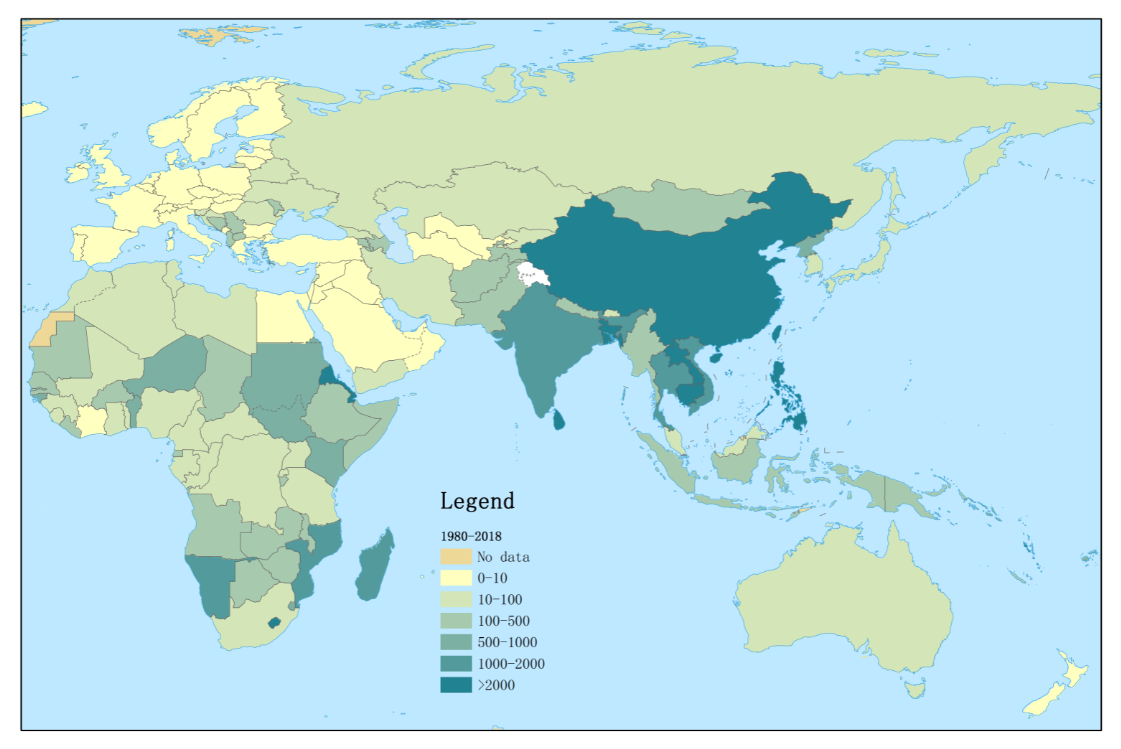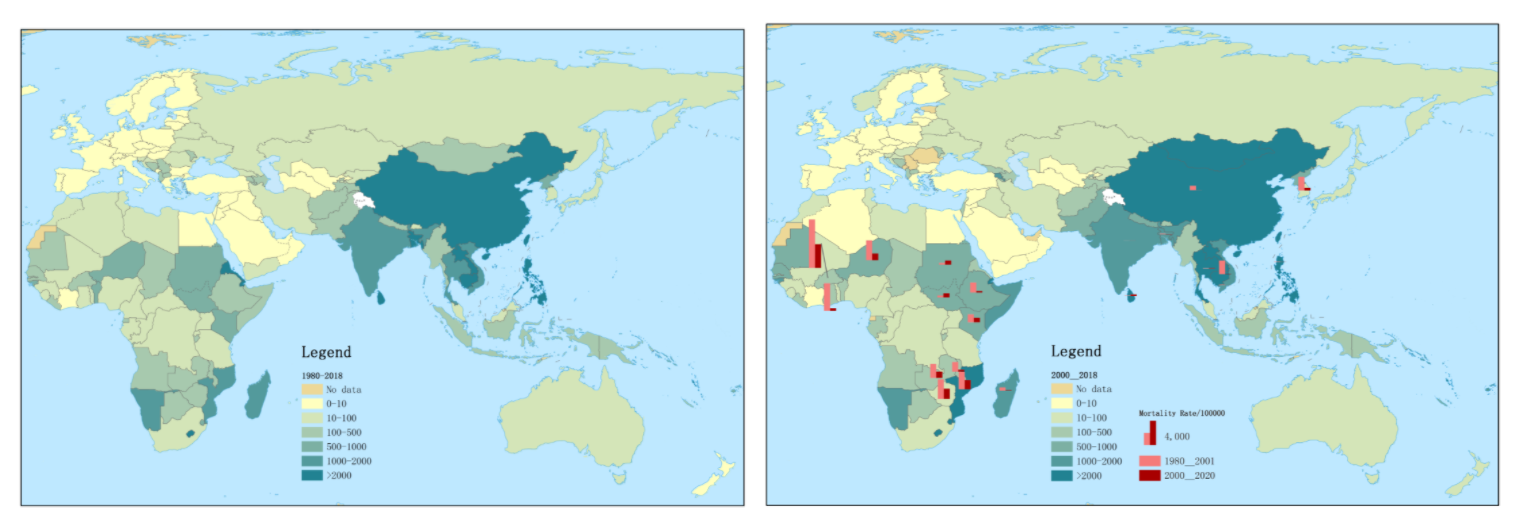SDG13: Climate Action
Disaster monitoring and analysis of the SDG 13.1.1 indicator in countries and regions along the Belt and Road(2019)
Scale: Regional


Study area: Belt and Road Region
The disaster data used in this case was obtained from the International Disaster Database - Emergency Events Database (EM-DAT), for the duration from 1980 to 2018. The EM-DAT database is widely used in disaster management and research at the national scale. It is categorized according to different disaster events, which is a convenient way to manage and analyze natural disasters. The database is used by many journals, newspapers, and UN agencies, including the Economic and Social Commission for Asia and the Pacific (ESCAP) and WHO. It is used for research purposes in order to better understand and deal with disasters. The frequency of different types of natural disasters, the casualties, and the number of affected people are calculated based on values from the database. Changes in global disaster losses after the SDG agenda was proposed were monitored to understand spatiotemporal patterns, key time points, and critical areas.
Target 13.1: Strengthening resilience and adaptive capacity to climate-related hazards and natural disasters in all countries.
Indicator 13.1.1: Number of deaths, missing persons and persons affected by disasters per 100,000 people.
Method
Based on indicator 13.1.1, statistics were obtained for the types of natural disasters, the frequency of occurrence, the number of deaths, and the number of missing and affected people in countries and regions along the Belt and Road from 1980- 2018. The SDG 13.1.1 indicator was then calculated for each corresponding country. The proportion of deaths from natural disasters was used to assess the effectiveness of disaster risk reduction in each country.
Data used in this case
The international disaster database EM-DAT (https://www.emdat.be/).
Results and analysis
The analysis of available data shows that the total number of people affected by disasters in Asia, Africa, Oceania, and Europe between 1980 and 2018 was 6 billion, among which 1,840,000 were deaths. Asia has the highest number of people affected, reaching 5 billion and accounting for 86.93% of the total number of people affected by disasters. In order to explore the situation in Asia and Africa over the past 40 years, based on the annual population data of each region, the changing trends in Asia and Africa from 1980 to 2018 were analyzed, as shown in Figure 1. Overall, countries affected severely by natural disasters (SDG 13.1.1 > 1,000) are mainly located in Southeast Asia and central and southern Africa, including developing and underdeveloped countries like China, India, Pakistan, Myanmar, Laos, the Philippines, Namibia, Sudan, Mozambique, and Ethiopia. These countries were affected severely by disasters, including large death tolls, so they have taken on a heavy responsibility and a long course of prevention and mitigation for disasters.

Figure 1. SDG 13.1.1 of countries and regions along the Belt and Road during 1980-2018.
Indicator performance for all countries before and after 2000 shows that the overall values in the countries and regions along the Belt and Road have declined, which means most countries have achieved some success in their disaster reduction policies (Figure 2). Among the 20 high-risk countries, the indicator value declined in 13 countries after 2000. In other countries, like China, the indicators have increased but the rate of deaths from disasters dropped considerably. In addition, China's rate of deaths is lowest among 20 high-risk countries, and it dropped from 700/100,000 to 6/100,000 after 2000. At the regional level, the indicator in Asia, Africa, Oceania, and Europe have all declined significantly after 2000. In 11 of the 17 regions, the impact of disasters has been controlled to some extent. However, the indicators in Central Asia, Southeast Asia, South Asia, Southern Africa, Eastern Europe, and Melanesia in Oceania were still rising. Disaster reduction is most effective in East Asia and Oceania. In short, countries and regions with higher levels of economic development are better able to withstand and reduce disaster losses than countries with a lower economic development level.

Figure 2. SDG 13.1.1 of countries and regions along the Belt and Road during 1980-2000 (left) and 2000-2018 (right).
| Highlights |
| Overall, since 1980, the countries most impacted by natural disasters have been mainly located in Southeast Asia and central and southern Africa, and these countries and regions have a long way to go in terms of resilience and reduction of disaster losses. Compared with the SDG 13.1.1 indicators of countries around 2000, the overall indicators of the countries and regions along the Belt and Road have declined. Among the 20 high-risk countries, the indicators in 13 high-risk countries have decreased after 2000. In other countries, like China, the indicators have increased but the proportion of deaths caused by natural disasters dropped considerably. All of these data indicated that most countries and regions have achieved some results in disaster reduction. |
Outlook
Generally, the impacts of disasters are closely related to the economic development of each country. For countries with high frequency of disasters and high casualties, while developing their own economies, they should also cooperate with the UN's disaster reduction agency to strengthen capacity building in resisting and reducing disaster losses. In the future, CASEarth will continue to monitor the SDG 13.1.1 indicator in various countries and regions. Meanwhile, remote sensing and geographic information technology will be used to produce spatial products for typical climate disasters in the Belt and Road countries, and the results can provide technological support for disaster reduction.

